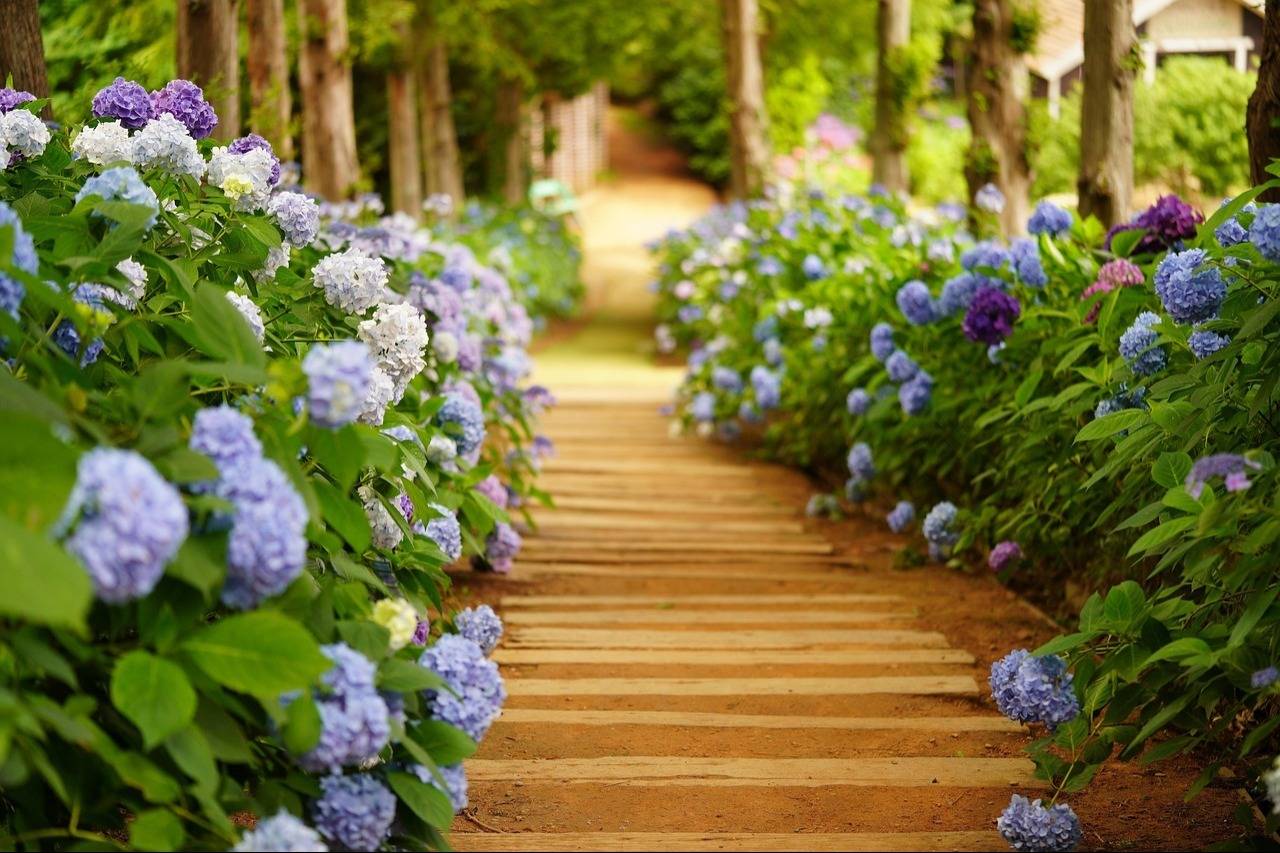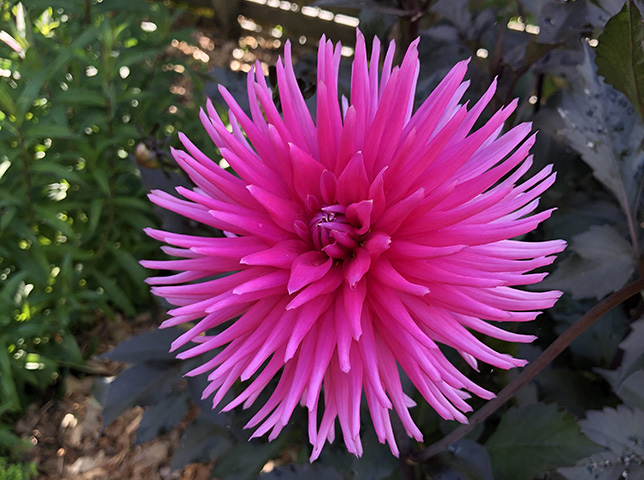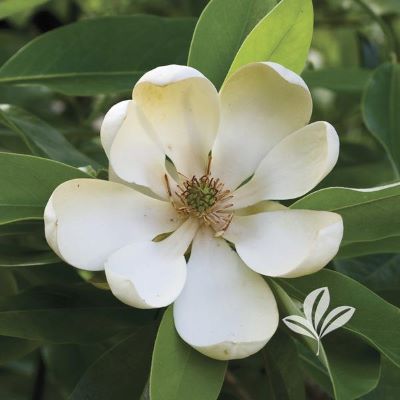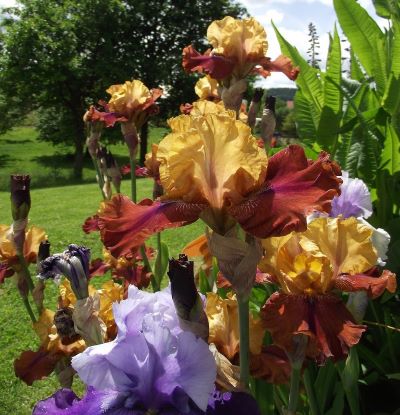If you’ve ever admired the showy, globe-like clusters of white, pink, or blue blooms in gardens or floral arrangements, you’ve likely encountered the stunning hydrangea. This versatile and beautiful shrub has been a favorite of gardeners for centuries, with its showy flowers and adaptable nature making it a top choice for landscaping, as well as a popular cut flower. In this guide, we’ll explore the different species of hydrangeas along with their care, design uses, and popular cultivars. Whether you’re a beginner or an experienced gardener, there's something for everyone when it comes to these gorgeous plants.

Hydrangeas: A Summer of Color For Your Garden
The hydrangea is native to parts of both Asia and the Americas. The name "hydrangea" comes from the Greek words hydor, meaning water, and angeion, meaning vessel, which actually refers to the seed capsule shape and only coincidentally to the plant's preference for consistent moisture. While hydrangeas have been cultivated for centuries, they gained popularity in Europe during the 19th century, as European botanists brought them back from Japan and China. French breeders introduced a great number of varieties in succeeding decades. Since then, hydrangeas have been cherished for their beauty, diverse color options, and ease of cultivation.
Hydrangea Species and Varieties
Hydrangea flowers are as diverse as the species themselves. From the delicate lacecap blooms of Hydrangea serrata to the large, mophead blossoms of Hydrangea macrophylla, there’s something for every taste. The flowerheads range can be rounded, ball-like clusters or more open, pyramidal panicles, with individual florets sometimes serrated, star-shaped, or double. Their colors, too, vary widely: white, pink, purple, blue, and even green, with some varieties changing color throughout the growing season.
Foliage is medium green and attractive when not in bloom, with some variegated forms available. Oakleaf hydrangeas are known for their spectactular fall color in shades of russet red, fiery orange, and bright gold, adding yet another dimension to the landscape. The dried blossoms also tend to be fairly persistent, and look stunning in a coating of fresh snow.
Several species of hydrangea are available for the home garden, offering unique characteristics in terms of flower shape, size, color, and growth habits, each with myriad cultivars as well. Here are the most common types you’ll encounter:

Below, 'Limelight' panicle hydrangea in winter. The blooms of most hydrangeas are easily dried and preserved for use in crafts. Photo courtesy Proven Winners.

Hydrangea macrophylla (Bigleaf Hydrangea)
Most cultivars introduced before 2004 only set flower buds on old wood, so pruning must be accomplished immediately after blooming to avoid cutting off next season's display. Since 2004, with the release of 'Endless Summer' hydrangeas, growers have concentrated their efforts on "rebloomers" that also flower on new wood, but old-wood bloomers are still available in commerce. Read plant labels carefully or research before buying if that trait is important to you. Note that even reblooming varieties may suffer winter kill of flower buds in colder zones, so performance may not match that of those grown in warmer climates. Zones (4)5-9 for most rebloomers, old-wood bloomers best in zones 6-9.
Beautiful in the shrub or perennial border, as specimen or massed, foundation plantings, or any semi-shady spot where the spectacular flowers can be appreciated. Smaller cultivars can be container grown with sufficient water (during a hot summer this could be almost daily), with root protection over winter needed in colder areas. Plant where protected from afternoon sun in hot climates and frigid winter winds in northern zones. Susceptible to occasional bacterial leaf spot and powdery mildew, but their biggest issue is their seeming irresistibility to deer.
This is also the most common hydrangea species forced and sold in nurseries or by florists, often for Mother's Day and Easter. These will rarely be marked with a cultivar name, but growers often use non-patented (and therefore less expensive), old-wood blooming varieties like 'Mathilda Gutges', 'Merrit's Supreme', 'Sister Theresa', and 'Blue Danube.' These may or may not be winter hardy in the location where they are sold. If planted in spring after the blooms fade they may return to life the next year, but will likely take 2 years to bloom again, assuming the buds can winter over. Most of these will be hardy to at least zone 6, so you should plan on giving them winter protection in zones above that to give them a chance.
Notable Cultivars:
- 'Endless Summer' and friends: The original 3 to 5' sized blue (or pink) mophead has since been joined by 5 additional varieties: the 18-36" blue ( or pink) lacecap 'Pop Star', 3-4' pink (blue) lacecap 'Twist-n-Shout,' 18-36" raspberry red (or purple) mophead 'Summer Crush', 3-4' high x 4-5' wide rose pink (or purplish-blue) mophead 'Bloomstruck', and 3-6' 'Blushing Bride' with mophead flowers that age white to pink. 'Bloomstruck' and 'Twist-n-Shout' have red stems which may not be that visible on a nice, full plant, but may add some additional interest before fully leafed out, and in youth. All claim to do well in zones 4-9, and all bloom on old and new wood.
- 'Let's Dance' Series: 7 varieties. 'Can Do' (3-4' rose/purple-blue lacecap with semi-double star-shaped florets) and 'Sky View' (2-3', pink/sky blue mophead) are touted as "continuous blooming," blooming earlier on the new wood, and having a better ability to winter over buds on old wood. Both zones 4-9. Others include 1-2' blue/pink mophead 'Blue Jangles,' 2.5' pink/blue mophead 'Big Band,' 3-4' x 2-3' blue/pink mophead 'Rhythmic Blue,' and 3-4' warm pink/purple 'Lovable,' all zones 5-9. 'Arriba' is a pink-purple mophead that grows to 2-3, and has increased cold hardiness, being a hybrid with H. serrata, zone 4-9.
- 'Cityline' Series: Compact plants grow to 1 to 3 feet, blooms only on old wood. Notable for unique bicolor effect, each individual flower starting out with a light green or white eye and the color deepening as the flower matures. 6 colors in the series.
- 'Eclipse': Dark purple, almost black leaves and large cranberry or amethyst mophead blooms (pH dependent) on old and new wood. Grows 3 to 5 feet high and wide. Zones 5-9.
'Zebra': Noted for its black stems and deep green foliage that display nicely against the bright white mophead blooms that start out pale green. Grows 4' x 3', blooms on old & new wood. Zones 5-9.
- 'Forever Pink': Mophead with 3 to 5 inch diameter pink flowers that bloom a bit earlier than other varieties, grows 3' x 3' with strong stems capable of holding the heavy flowers without bending. Blooms on old and new wood. Zones (5)6-9.
- 'Variegata': Lacecap flowers with cream-edged leaves on a 3 foot high and wide plant. If solid-green leaved shoots are not removed the plant may revert entirely, even to one with mophead flowers. Blooms only on old wood. Zones 6-9.
- 'Nikko Blue' and 'Blue Wave': These were the old "blue" landscape standbys before reblooming types were developed, and may still be found. Both typically grow larger, to 6'. Both bloom on old wood, Nikko with mopheads and Blue Wave with lacecap flowers. Zones 6-9.
- 'Pia': Smaller variety grows to 3' with numerous 3 to 4 inch flowerheads. Blooms on old wood.
- 'Fairytrail' Series: Hybridized in Japan, these old-wood bloomers exhibit a gentle cascading habit with flowers all along the stem, rather than only at the ends. 'Fairytrail Bride' grows to 4' with 5 inch white lacecap flowers (zones 7-9), 'Fairytrail Fresco' bears green-tinged pale blue or pink mophead blooms on a 3.5-4' high x 4.5' wide plant (zones 5-9).
Hydrangea paniculata (Panicle Hydrangea)
These hydrangeas have cone-shaped flower clusters and are more tolerant of sun and cold than other varieties. They bloom in summer to fall, with flowers transitioning from white to pink to red over a long season. The species is a large, fast-growing upright spreading shrub or small tree with semi-arching branches that can reach 10-20 feet in height and spread; the cultivar 'Grandiflora' (PeeGee hydrangea) was the most commonly planted. Occasional issues with bud blight, rust, mildew, and leaf spot. Less appealing to deer than most other species of hydrangea.
Recent breeding has brought about a number of cultivars that range from 3 to 6 feet that are better suited to smaller gardens. Larger varieties suitable for quick deciduous privacy screen with the best form achieved by regular pruning to 6 to 10 feet; smaller types provide late summer blooms in the shrub border. Adaptable and grows well in urban conditions, but possibly more sensitive to poor soil drainage than other hydrangeas. Flowers on new wood.. Zones 3-8(9).
Notable Cultivars:
- 'Limelight': 6-8' high and wide; large cone-shaped heads of flowers emerge white and progress to lime green to pink to deep rose. Red fall color.
- 'Limelight Prime': "Improved" 'Limelight,' featuring a bit earlier bloom, more vivid color, stronger stems to hold flowers more upright, and a smaller habit of 4-6' high and 4-5' wide.
- 'Little Lime': 3-5' high and wide; spherical flowerheads of light green change to pink and burgundy tones and are held well upright. Negligible leaf fall color.
- 'Little Lime Punch': Similar to 'Little Lime,' but blooms change color from the bottom up, giving each one a two-tone or layered color effect, with all colors often present on the plant at the same time.
- 'Quick Fire': 6-8' high x 4-6' wide; one of the earliest to bloom, as much as a month before other varieties. Airy 6" long flower clusters change from white to pink. Gold and red fall color.
- 'Little Quick Fire': Smaller version of 'Quick Fire' at 3 to 5 feet high and wide. No fall color.
- 'Tiny Quick Fire': Smaller yet! 1.5-3' high x 2-3' wide, no appreciable fall color.
Hydrangea arborescens (Smooth Hydrangea)
Hydrangea arborescens (Smooth Hydrangea) – The Eastern US native smooth hydrangea thrives in shadier areas and is often used for natural, woodland gardens. However, it can be grown in full sun with sufficient moisture. While the native species bears lacecap flowers, its most famous variety is Annabelle, with very large, white, ball-shaped clusters that can be effective for as long as two months in summer. Most available cultivars will also display the mophead type blooms in shades of white, green or pink, not influenced by soil pH. Improved varieties feature stronger stems to prevent the weighty flowerheads from causing the plant to bow to the ground.
Plants grow 3 to 5 feet high and wide, and may sucker from the roots to cover a large area. Blooms on new wood, so may be pruned to the ground in winter (the winter silhouette is unkempt and unattractive), and again after the first bloom for a possible second flush of flowers. However, this may encourage floppy stems in some cultivars. Beautiful in the shrub or mixed border or massed in woodland plantings, and excellent for dried flowers. Somewhat susceptible to leaf spot, mildew, rust, bud blight and occasionally aphids. Tolerant of siting near black walnut, and like H. paniculata is less prone to deer browsing than other hydrangeas. Zones 3 to 9.
Notable Cultivars:
- 'Annabelle': The old favorite, with large 8-12" wide white flowerheads in June and July and may repeat in fall. Grows 3 to 5 feet high with a 4-6 foot spread with somewhat lax stems that may bend over with the weight of the massive flowers.
- 'Incrediball': Grows 4-5' with stronger stems that hold the enormous flowers upright. Flowers are larger and more densely packed than 'Annabelle', emerging soft lime green and turning white. Zones 3-8.
- 'Invincibelle' Series, zones 3-8: Pink-flowering 'Spirit II' grows 3-4'; 'Mini Mauvette' grows 2.5-3' with mauve flowers; 'Ruby' grows 3-4' x 2-3' with two-toned light pink and ruby red blooms and very dark green foliage; 'Lace,' 4-5' with lacecap flowers deep pink in the center with white outer florets; 'Blush' 4-5' with 6" wide silvery pink blooms; 3-4' high and wide 'Limetta' starts out lime green, turning soft greenish-white before finally maturing to jade green; 1-2.'5' 'Wee White' with blush pink buds that open white.
- 'Lime Rickey': 4-5 feet with strong stems and lime green flowers that age to jade green. Zones 3-8.
Hydrangea quercifolia (Oakleaf Hydrangea)
With deeply lobed, oak-like leaves, this hydrangea variety features beautiful late spring to summer white blooms that turn pink as they mature. The foliage and exfoliating bark on mature branches also provides interest in the fall, with vibrant red, orange, and purple hues. Grows in full sun to part shade, to 6 to 8 feet on average. More disease resistant than bigleaf or smooth hydrangeas. Pruning seldom needed, blooms on old wood. Use as specimen or group for deciduous hedge or in shrub borders and woodland plantings. Zones (5)6-9.
Notable Cultivars
- 'Alice': 10-14" white flower panicles on arching stems with a broad rounded habit, growing to 5-8' or more.
- 'Snow Queen': Grows 4-6' with stronger stems and up to 12" white flowerheads that age to pink.
- 'Ruby Slippers': 10" long inflorescences emerge white and age to shades of pink on a 3-4' shrub.
- 'Gatsby Pink': Grows to 6-8' with wide, conical airy flower panicles that age from white to pink with deep pink undersides.
- 'Gatsby Moon': Densely packed, wide, pyramidal white flowerheads with double florets that mature to green on a 6-8' shrub.
- 'Gatsby Star': Large, lacy panicles of double star-shaped white florets age to pink in fall, grows 6-8' high and wide.
- 'Pee Wee': 3 to 4' with somewhat smaller ivory-white blooms.
- 'Jetstream': Very dense, pyramidal white flowerheads on a compact, well-branched 5 to 6 foot shrub.
- 'Little Honey': Unique for its spring to early summer bright gold foliage, this bears 5 inch long white flower panicles that mature to dusky pink on a 3 to 4' shrub. Leaves turn chartreuse and then green in summer, with red fall color.
Hydrangea serrata (Mountain Hydrangea)
A smaller variety, typically found in higher altitudes in Asia, mountain hydrangeas are similar to bigleaf hydrangeas but are more tolerant of colder temperatures. Their flowers tend to have a more delicate, lacecap appearance.
Notable Cultivars:
- 'Tuff Stuff': Pink or blue lacecap grows 2-3' (although I've had mine for 5 years and it is every bit of 4' x 4'). Blooms on old and new wood. Zones 5-9.
- 'Tuff Stuff Ah-Ha': Individual outer florets are large and double, resembling waterlilies, pink or blue on old and new wood, 2-3'. Zones 5-9.
- 'Tiny Tuff Stuff': Smaller version said to grow only18 to 24 inches high and wide. Blooms on old and new wood. Listed as Zones 4-9.
- 'Fuji Waterfall': Very attractive with pure white 6-12" lacecap blooms on old and new wood, the outer 1 inch florets are double and resemble small waterlilies. 4-5', Zones 5-9.
- 'Kogane Suruge': Grown for green-streaked golden foliage that can be all gold where it can be sited with more sun. White lacecap flowers typical of the species, but not a heavy bloomer. Zones 5-9.
Hydrangea anomala subsp. petiolaris ( Climbing Hydrangea)
A large-growing deciduous woody vine, it is the most shade tolerant of all the hydrangeas but can also handle full sun. Climbs via the use of clinging rootlets up to 30 feet or more, very slowly until established but more rapidly thereafter. Flat-topped, 6 to 10-inch wide lace-cap style white flowers are sweetly fragrant, and make a spectacular show for 2-3 weeks in summer. Cinnamon-brown bark displays an attractive exfoliating habit and bright yellow fall color is another bonus. Wonderful covering a pergola, fence, or wall. Zones 4-8.
Note that there are other plants also called "climbing hydrangea": Schizophragma hydrangeoides (zones 5-9) 'Moonlight' has similar white lacecap flowers and attractive silver variegated leaves; 'Flirty Girl' grows 40-50 feet and blooms readily with white flowers; 'Rose Sensation' is a less vigorous pink flowered variety with green foliage. Native Decumaria barbara 'Barbara Ann,' is a broadleaf evergreen vine growing up to 40 feet with fragrant white flowers in spring.
How to Care for Hydrangeas
Hydrangeas are relatively easy to care for, but they do require specific conditions to thrive. Here are key factors to consider when planting and caring for these lovely shrubs:
Siting and Planting Hydrangeas
Hydrangeas generally prefer partial sun. In general, the cooler the climate the more sun the plant will accept, regardless of the species. Select a spot that receives morning sun and afternoon shade, or all day dappled sunlight, as hydrangeas need some sun to bloom well but can benefit from protection during the hottest part of the day, especially in more southerly zones. Sites safe from winter winds will help protect overwintering flower buds.
The amount of sunlight can also impact the longevity of the floral display. The blooms of many cultivars, especially those of panicle and oakleaf hydrangeas, change color as they mature, usually in a white to pink to deep red progression, or white to lime green. In full sun, these flowers may never fully express that range of color that develops over a period of months as temperatures cool, instead simply fading to brown after a few weeks.
When planting, ensure that the soil is well-drained but retains moisture. Hydrangeas have shallow root systems, so regular watering is essential, especially during hot, dry spells. Current best practices do not recommend amending the soil in the planting hole to avoid the "bucket effect," where water may collect in the improved soil around the new plant due to the drastically different texture from the native soil surrounding it, causing root rot. This is especially a problem in heavy clay soil, which is naturally the most frequently amended. As the initial symptoms of overwatering are similar to those of underwatering, the problem is further aggravated by attempting to counteract yellowing leaves and wilting with the addition of more water.
Watering Hydrangeas
Hydrangeas love water but don’t like to sit in waterlogged soil. Ensure proper drainage, and water deeply, especially during dry periods. Mulching around the base helps retain moisture and keeps the roots cool during the summer months. Avoid planting close to evergreens with shallow root systems that may compete for water. Bigleaf and mountain hydrangeas will require the most water, oakleaf hydrangea usually the least.
Fertilizing Hydrangeas
Hydrangeas benefit from regular feeding during the growing season. Use a balanced, slow-release fertilizer in early spring, and again in mid-summer if needed. Avoid over-fertilizing, as it can lead to lush foliage but fewer blooms, and to weak, floppy stems in smooth hydrangeas.
Pruning Hydrangeas
Pruning hydrangeas depends on the species and cultivar, but they should not be pruned for shape and size as one might a typical hedge plant. Panicle and smooth hydrangeas bloom on new wood, so they can be pruned in late winter or early spring before they start growing.
If needed, bigleaf hydrangeas that bloom on old wood should be pruned directly after flowering is finished to avoid cutting off next year’s buds. Regular pruning helps maintain the plant’s shape and encourages more blooms. In general, thinning by removing older stems at the base is best. In winter, remove about 1/3 of the stems, concentrating on wood 3 years old and older. If you haven't pruned in a while, you may find a lot of dead wood that can be pulled out with very little effort. Thinning the plant in this fashion also increases air circulation, lessening the chance of foliar disease while maximizing the floral display.
pH Considerations for Pink or Blue Flower Coloration in Hydrangeas
Hydrangeas are quite adaptable, but they do best in moist, well-drained, slightly acidic , humus rich soil. The soil pH has a bearing on aluminum availability, which influences the color of bigleaf and mountain hydrangea blooms. In acidic soil (pH below 5.5), these hydrangeas produce blue flowers, while in more alkaline soil (pH above 6), they tend to be pink. For a deeper blue, add sulfur to lower the pH; to make them pink, add lime to raise it. Note that this can take several months and can take longer to turn the flowers from blue to pink than pink to blue. Plants sited very near foundations or sidewalks might be more difficult to change to blue, as the soil will usually be more alkaline due to the leaching of lime from the concrete or masonry materials. Very high phosphorus conditions even in low PH soil may reduce the amount of aluminum available to the plant, thus preventing a desired pink coloration. Red flowers may turn purple in acidic soil, while white flowers are not affected.
Design and Landscaping Uses for Hydrangeas
Hydrangeas are incredibly versatile in the landscape, whether you’re designing a formal garden, a cottage garden, or even a woodland setting. Their large, showy flowers make them a stunning focal point in mixed borders, and their blooms are effective over a very long season in summer. When grown with sufficient water, their foliage is attractive from spring to fall, with some species like oakleafs displaying rich fall color. Plant them in groupings for maximum visual impact, or use them as hedges for privacy and structure. Because hydrangeas come in a range of sizes, from compact varieties to larger shrubs, they work well in a variety of spaces—from small patios to expansive gardens. You can even grow hydrangeas in containers for a pop of color on balconies or patios. Their rich foliage and bloom color variations also make them an ideal choice for color contrast and texture in your garden.
Hydrangeas as Cut Flowers and in Crafts
Hydrangeas are one of the most popular cut flowers and a favorite for weddings, thanks to their long-lasting blooms and large, eye-catching flower heads. Whether used in floral arrangements, wreaths, or bouquets, they add a touch of elegance to any occasion. As a craft material, dried hydrangea blooms are a favorite for making wreaths, garlands, and decorative accents. To dry hydrangeas, simply cut the stems when they are in full bloom, and hang them upside down in a cool, dark place.
In Conclusion
Whether you’re a novice gardener or a seasoned pro, hydrangeas are a fantastic addition to any garden. With their variety of species, stunning flowers, and adaptability to different climates and conditions, hydrangeas offer endless possibilities for gardeners looking to create beauty in their landscapes. By following a few simple care guidelines, you can enjoy these beautiful blooms for years to come. Have hydrangeas now? We'd love to know which ones you love and how they grow for you - leave your comments and perhaps you'll inspire others to try something new!
































